Related Research Articles
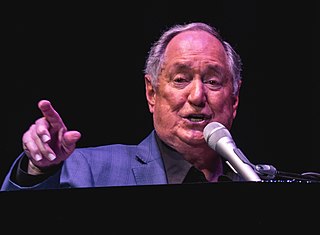
Neil Sedaka is an American singer-songwriter and pianist. Since his music career began in 1957, he has sold millions of records worldwide and has written or co-written over 500 songs for himself and other artists, collaborating mostly with lyricists Howard "Howie" Greenfield and Phil Cody.
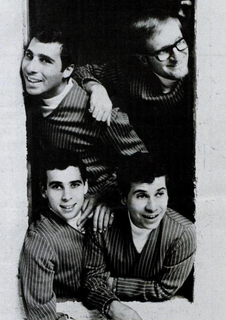
The Tokens were an American doo-wop band and record production company group from Brooklyn, New York City. The group has had four top 40 hits on the Billboard Hot 100, all in the 1960s, their biggest being the chart-topping 1961 hit single, "The Lion Sleeps Tonight". "The Lion Sleeps Tonight" borrowed heavily from the 1939 song "Mbube" by South African singer Solomon Linda. They are also known for having included at first Neil Sedaka, who later pursued a solo career.

Howard Greenfield was an American lyricist and songwriter, who for several years in the 1960s worked out of the famous Brill Building. He is best known for his successful songwriting collaborations, including one with Neil Sedaka from the late 1950s to the mid-1970s, and near-simultaneous songwriting partnerships with Jack Keller and Helen Miller throughout most of the 1960s.

"Breaking Up Is Hard to Do" is a song recorded by Neil Sedaka, co-written by Sedaka and Howard Greenfield. Sedaka recorded this song twice, in 1962 and 1975, in two significantly different arrangements, and it is considered to be his signature song. Between 1970 and 1975, it was a top-40 hit three separate times for three separate artists: Lenny Welch, The Partridge Family and Sedaka's second version.

"Love Will Keep Us Together" is a song written by Neil Sedaka and Howard Greenfield. It was first recorded by Sedaka in 1973. American pop duo Captain & Tennille covered the song in 1975, with instrumental backing almost entirely by “Captain” Daryl Dragon, with the exception of drums played by Hal Blaine; their version became a worldwide hit.

"Lonely Night " is a song written by Neil Sedaka. The song was first recorded by Sedaka and appeared as a track on his 1975 studio album, The Hungry Years. The following year the song was made popular when covered by the pop music duo Captain & Tennille, who took their version to number 3 on the Billboard Hot 100.
"Stupid Cupid" is a song written by Howard Greenfield and Neil Sedaka which became a hit for Connie Francis in 1958.
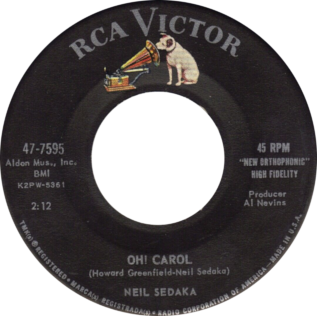
"Oh! Carol" is an international hit written by Neil Sedaka in 1958. Co-written with Howard Greenfield, the song is noted for Sedaka's spoken recitation of the verse, the second time around.
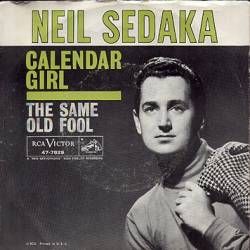
"Calendar Girl" is a song by Neil Sedaka. The music was composed by Sedaka and the lyrics by Howard Greenfield. Recorded in 1959 and released in December 1960 as a single, it was a Top-5 hit single for Sedaka, peaking at No. 4 on the US charts, No. 3 in Australia, and No. 1 on the Canadian and Japanese charts.
Rock with Neil Sedaka or just Neil Sedaka is the first major solo album of Neil Sedaka released in 1959 after two 1958 albums under the titles Neil Sedaka and The Tokens and Neil Sedaka and The Tokens and Coins. The album was released by RCA Victor and was produced by Al Nevins. The album contains 12 songs, all of them co-written by Sedaka and his friend Howard Greenfield. Two of the songs became successful singles for Sedaka from the album, namely "The Diary", his debut single that was a hit, reaching No. 14 on the US Billboard charts, and "I Go Ape", a single that was relatively successful in the United States reaching No. 42, but did far better in the UK Singles Chart, making it up to No. 9 and his debut single in the United Kingdom.
"I Go Ape" is the second single by Neil Sedaka, immediately following his success with the debut single "The Diary", and was written by Sedaka himself and Howard Greenfield. It was released in 1958, and also appears on Sedaka's 1959 debut solo album Rock with Sedaka. The rock and roll novelty song, which name-checks various primates, was performed in the boogie-woogie style of Jerry Lee Lewis.

Neil Sedaka Sings Little Devil and His Other Hits is a solo album by Neil Sedaka released in 1961 immediately after the cover versions of earlier hits in Circulate.

"Stairway to Heaven" is a song written by Neil Sedaka and Howard Greenfield. It was released as a 45 rpm single and appeared on Sedaka's 1960 album Neil Sedaka Sings Little Devil and His Other Hits.
"Run Samson Run" is a song written by Neil Sedaka and Howard Greenfield and sung by Neil Sedaka. It appears on his album Neil Sedaka Sings Little Devil and His Other Hits. The song was included in Neil Sedaka Sings His Greatest Hits (1959–1963).
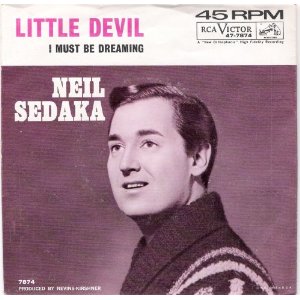
"Little Devil" is a song written by Neil Sedaka and Howard Greenfield and was released in 1961 as a single by Sedaka. It was the title track of Sedaka's 1961 album Neil Sedaka Sings Little Devil and His Other Hits. It became a hit for him reaching #11 in the US Billboard Charts.
The following is a comprehensive discography of Neil Sedaka, the American singer.
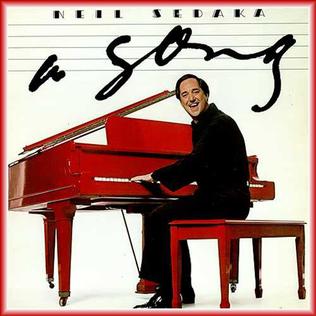
A Song is an in-studio album containing the works of American pop star Neil Sedaka. It was produced by George Martin and released in 1977 on the Elektra label in the US, marking the beginning of Sedaka's association with Elektra, which would run through 1981. Outside of the US, A Song was released on the Polydor label. After several record labels released bootleg CD's sourced from vinyl pressings over the years, the album was officially remastered and released on CD and digital platforms on November 11th, 2022.
"Next Door to an Angel" is a rock and pop song written by Neil Sedaka and Howard Greenfield and recorded by Neil Sedaka in 1962. It was issued by RCA Victor Records. It reached No. 5 on the Billboard Hot 100 in late 1962. "Next Door to an Angel" also went to No. 19 on the Hot R&B Singles chart. It was Sedaka's last appearance on the American Top 10 until "Laughter in the Rain" in late 1974.

"Where the Boys Are" is a song written by Neil Sedaka and Howard Greenfield for, and first recorded by, Connie Francis as the title track of the 1960 movie by the same name in which she was co-starring.

"Our Last Song Together" is a 1973 song recorded by Neil Sedaka. It is a track from his LP The Tra-La Days Are Over, and was the third of four single releases from the album.
References
- ↑ "Profile of Neil Sedaka" . Retrieved 2016-07-03.
- ↑ "Today's Mini-Concert - 7/16/2020". YouTube. Archived from the original on 2021-11-07. Retrieved June 14, 2021.
- ↑ TheNickNicola (2011-11-12), LITTLE ANTHONY & THE IMPERIALS- THE DIARY , retrieved 2016-07-04[ dead YouTube link ]
- ↑ "The Diary by Neil Sedaka Songfacts". www.songfacts.com. Retrieved 2016-07-04.
- ↑ "Neil Sedaka". www.history-of-rock.com. Retrieved 2016-07-03.
- ↑ CatsPjamas1 (2011-10-22), Neil Sedaka - The Diary (1958), archived from the original on 2021-12-21, retrieved 2016-07-04
- ↑ "CHUM Hit Parade - January 19, 1959".